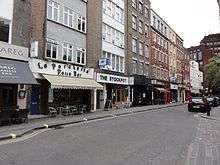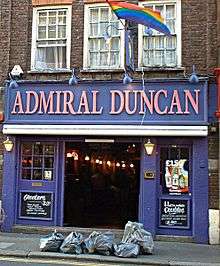Old Compton Street


Old Compton Street is a road that runs east–west through Soho in the West End of London.
History
The street was named after Henry Compton who raised funds for a local parish church, eventually dedicated as St Anne's Church in 1686. The area in general and this street in particular became the home of Huguenots, French Protestant refugees who were given asylum in England by Charles II in 1681.
By the end of the 18th century, fewer than ten of the houses were without shop fronts. In the middle of the 19th century, while there were some workshops too, as well as restaurants and public houses, the ground floors of most of the houses were still used as shops. The number of people of overseas descent continued to grow and the street became a meeting place for exiles, particularly those from France: after the suppression of the Paris Commune, the poets Arthur Rimbaud and Paul Verlaine often frequented drinking haunts here.
Old Compton Street had its resident curiosity in the form of Wombwell's Menagerie. George Wombwell kept a boot and shoe shop on the street between 1804 and 1810 and, by all accounts, was quite an entrepreneur. Of short statue and an alcoholic, he nonetheless built up three hugely successful menageries from a starting point of two snakes bought at a bargain price. The menageries travelled around England and made him a wealthy man before his death in 1850.
Between 1956 and 1970 the 2 I's Coffee Bar was located here. Many well-known 1960s pop musicians played in its cramped surroundings.
Current
Today, the street is the centre of London's gay community. In the middle of Soho, it features several gay bars, restaurants and cafés, as well as a popular theatre. Whilst a pedestrianisation project proved unpopular with local traders and was reversed, the street is closed to vehicular traffic for the Soho Pride festival one weekend each year, in late summer.
The Prince Edward Theatre is located on the east end of the street. Until 2004 the long-running production of Mamma Mia!, a musical based upon the songs of ABBA, was showing at the theatre. When Mamma Mia! moved to larger premises in another part of the West End, a production of Mary Poppins moved in, but closed in 2008. It is now home to Aladdin. London producer and director Adam Spreadbury-Maher lives at the northern end of Old Compton Street.[1]

In 1999, the Admiral Duncan pub was the site of a nail bomb attack which killed three people and injured over a dozen.[2] A neo-nazi, David Copeland, was subsequently found guilty of the bombing (intended specifically to injure members of the gay community). Previously decorated in neutral colours, the Admiral Duncan was re-opened with a flamboyant pink and purple exterior with a large rainbow flag flying outside as a symbol of gay pride. The flag has remained there ever since, in defiance of Westminster City Council's planning permission laws.
Along the street are numerous other gay bars including Comptons of SOHO and G-A-Y. Also on the street are a variety of cafés, tea rooms (including the original branch of the renowned Patisserie Valerie chain) and restaurants (including Bincho, London's only authentic yakitori restaurant, and Balans, which unusually for much of England is open 24 hours a day), and sex shops. Old Compton Street is also the home of some of London's film and video post-production houses.
An interesting local feature can be found in the middle of Charing Cross Road at its junction with Old Compton Street. Beneath the grill in the traffic island in the middle of the road, can be seen the old road signs[3] for the now-vanished Little Compton Street, which once joined Old Compton Street with New Compton Street.
Traffic and pedestrian issues
Night-time traffic surveys carried by Westminster City Council[4] between 10pm and 4am indicate that Old Compton Street, along with the adjoining Dean Street and Frith Street, experienced the highest levels of traffic within the Soho area.
The busiest location was Old Compton Street between the junctions with Dean and Frith Streets, which experienced ‘medium’ levels of traffic for four of the six hours of the survey, including between 2am and 4am.
Westminster Council stated that the narrow footways can become very congested at night, particularly at weekends, with people drinking in the street, eating outside takeaways, queuing at entertainment venues or to use bank ATMs, and people passing through the area. There are a number of premises with tables and chairs located on restricted pavement areas and this can cause a conflict between pedestrians and traffic.
In order to satisfactorily accommodate the number of visitors to the area, a campaign was established early in 2010[5] seeking to implement pedestrian priority works in this sensitive historic area.
Additional adjoining streets
- Wardour Street
- Greek Street
- Little Compton Street (now defunct)
See also
References
- ↑ "Adam Spreadbury-Maher". Gaydarnation.com. Retrieved 2012-07-16.
- ↑ "Dozens injured in Soho nail bomb". BBC News. UK: BBC. 30 April 1999.
- ↑ Way, Steve. "Photo". Flickr. Archived from the original on 18 December 2013.
- ↑ "SOHO ENTS SPG" (PDF). UK: Westminster Council. July 2006. Archived from the original (PDF) on 24 December 2013.
- ↑ "Saving Soho". UK.
External links
| Wikimedia Commons has media related to Old Compton Street. |
- Panoramic view at the junction with Dean Street
- Discovering Old Compton Street and New Compton Street
- Compton Street, Old and New
- CloneZone, London's oldest Gay sex shop
Coordinates: 51°30′48″N 0°07′53″W / 51.51326°N 0.13128°W